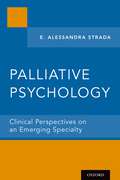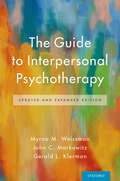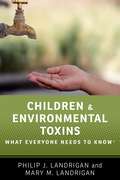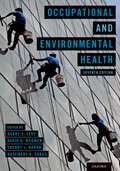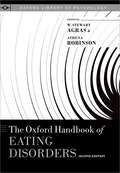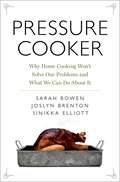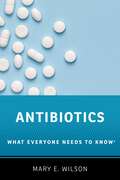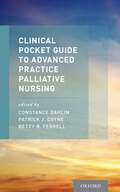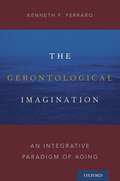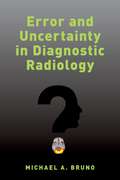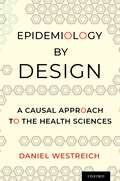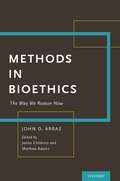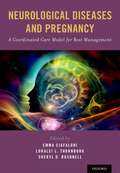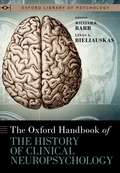- Table View
- List View
Palliative Psychology: Clinical Perspectives on an Emerging Specialty
by E. Alessandra StradaPalliative Psychology provides clinical, evidence-based training in palliative and end of life care for clinical psychologists to accomplish specific therapeutic goals. Chapters provide a clear road map for approaching assessment and treatment by reviewing the use of psychotropic medications for patients with advanced and terminal illness, basic but important aspects of pain medication, in depth psychological and psychiatric assessment for patients with advanced illness and their caregivers, and assessment tools, highlighting the specific clinical contexts for their use. The volume also includes evidence-based psychotherapy models that have been shown effective in treating various manifestations of psychological distress in patients and caregivers. In addition to clinical topics, Palliative Psychology addresses crucial and often sensitive professional issues, including communication and collaboration with medical providers and issues of stress and burnout. Psychologists will learn how to best communicate the results of their assessments and treatment plan goals to other care providers in order to foster collaboration and better position themselves as advocates for their patients. Insight-oriented and practical suggestions will help clinicians manage the emotional intensity of this work and channel the therapeutic potential of their emotional reactions into their work with patients and caregivers.
Healthier: Fifty Thoughts on the Foundations of Population Health
by Sandro GaleaFifty essays on the state of population health from a vanguard voice in the field Public health can rightly claim its share of victories: healthier cities, widespread sanitation, broader availability of nutrient-rich food, and reductions in violence and injury. But for all these gains, today we face a new set of challenges, ones complicated by political and professional shifts that threaten to fundamentally change the health of populations. Healthier is both an affirmation and an essential summary of the current challenges and opportunities for those working in and around the improvement of population health. The essays contained here champion an approach to health that is consequentialist and rooted in social justice -- an expansion of traditional, quantitatively motivated public health that will both inform and inspire any reader from student to seasoned practitioner. Galea's cogent, incisive arguments guarantee that his perspective, currently at the forefront of public health, will soon become conventional wisdom.
Healthier: Fifty Thoughts on the Foundations of Population Health
by Sandro GaleaFifty essays on the state of population health from a vanguard voice in the field Public health can rightly claim its share of victories: healthier cities, widespread sanitation, broader availability of nutrient-rich food, and reductions in violence and injury. But for all these gains, today we face a new set of challenges, ones complicated by political and professional shifts that threaten to fundamentally change the health of populations. Healthier is both an affirmation and an essential summary of the current challenges and opportunities for those working in and around the improvement of population health. The essays contained here champion an approach to health that is consequentialist and rooted in social justice -- an expansion of traditional, quantitatively motivated public health that will both inform and inspire any reader from student to seasoned practitioner. Galea's cogent, incisive arguments guarantee that his perspective, currently at the forefront of public health, will soon become conventional wisdom.
The Guide to Interpersonal Psychotherapy: Updated and Expanded Edition
by Myrna M. Weissman John C. Markowitz Gerald L. KlermanThe Guide to Interpersonal Psychotherapy is the definitive, practical guide to Interpersonal Psychotherapy (IPT) for clinicians and researchers. IPT is a well-researched, time-limited, and diagnosis-focused therapy. An update and expansion of the original 1984, 2000, and 2007 IPT manuals, this guide illustrates not only individual IPT treatment for patients with major depression but also adaptations of IPT for different diagnoses, patient populations, and treatment formats. This book is the basis for the extensive research that has validated IPT and led to its listing in treatment guidelines. Written by the originators of the treatment and one of its leading researchers, this updated and expanded guide describes how to approach clinical encounters with patients, how to focus IPT treatment, and how to handle therapeutic difficulties. IPT can be combined with medication, and it is a safe alternative to medication for individuals who may not be able to take antidepressants. IPT has been shown not only to relieve symptoms but to build social skills as well. Learn how to use IPT to effectively treat depression and other disorders including bipolar disorder, anxiety disorders, eating disorders, posttraumatic stress, and borderline personality disorder. With clinical examples and sample therapist scripts throughout, The Guide summarizes the theoretical and empirical background of IPT and focuses on teaching you the best way to deliver this effective, immensely practical treatment.
Children and Environmental Toxins: What Everyone Needs to Know® (What Everyone Needs To Know®)
by Philip J. Landrigan Mary M. LandriganMore than 80,000 new chemicals have been developed and released into the global environment during the last four decades. Today the World Health Organization attributes more than one-third of all childhood deaths to environmental causes, and as rates of childhood disease skyrocket -- autism, asthma, ADHD, obesity, diabetes, and even birth defects -- it raises serious, difficult questions around how the chemical environment is impacting children's health. Children and Environmental Toxins: What Everyone Needs to Know® offers an accessible guide to understanding and identifying the potential sources of harm in a child's environment. Written by experts in pediatrics and environmental health and formatted in an easy to follow question-and-answer format, it offers parents, care providers, and activists a reliable introduction to a hotly debated topic. As the burdens of environmental toxins and disease continue to defy borders, this book provides a new benchmark to understanding the potential threats in our environment and food. No parent or care provider should be without it.
CHILDREN & ENVIRONMENTAL TOXINS WENK C: What Everyone Needs to Know® (What Everyone Needs To Know®)
by Philip J. Landrigan Mary M. LandriganMore than 80,000 new chemicals have been developed and released into the global environment during the last four decades. Today the World Health Organization attributes more than one-third of all childhood deaths to environmental causes, and as rates of childhood disease skyrocket -- autism, asthma, ADHD, obesity, diabetes, and even birth defects -- it raises serious, difficult questions around how the chemical environment is impacting children's health. Children and Environmental Toxins: What Everyone Needs to Know® offers an accessible guide to understanding and identifying the potential sources of harm in a child's environment. Written by experts in pediatrics and environmental health and formatted in an easy to follow question-and-answer format, it offers parents, care providers, and activists a reliable introduction to a hotly debated topic. As the burdens of environmental toxins and disease continue to defy borders, this book provides a new benchmark to understanding the potential threats in our environment and food. No parent or care provider should be without it.
Occupational and Environmental Health
Praise for Previous Editions: "This splendid book [...]is authoritative, well written, and ably edited." - Occupational & Environmental Medicine "The book provides a logical, structured exposition of a diverse multidisciplinary speciality, employing a language and format designed to educate the novice student and seasoned practitioner alike - a vital contribution to the field." - New England Journal of Medicine Occupational and environmental contributions to the occurrence of disease and injury represent a core component of public health and health care. Factors in the workplace and the ambient environment have significant impacts on individual and community health. Occupational and Environmental Health is a comprehensive, practical textbook for understanding how work and environment influence individual and population health. Comprising 40 chapters written by national and international experts, this book combines theory and practical insights to help readers effectively recognize and prevent occupational and environmental disease and injury.
Occupational and Environmental Health
by Barry S. Levy, David H. Wegman, Sherry L. Baron, Rosemary K. Sokas and Heather L. McStowePraise for Previous Editions: "This splendid book [...]is authoritative, well written, and ably edited." - Occupational & Environmental Medicine "The book provides a logical, structured exposition of a diverse multidisciplinary speciality, employing a language and format designed to educate the novice student and seasoned practitioner alike - a vital contribution to the field." - New England Journal of Medicine Occupational and environmental contributions to the occurrence of disease and injury represent a core component of public health and health care. Factors in the workplace and the ambient environment have significant impacts on individual and community health. Occupational and Environmental Health is a comprehensive, practical textbook for understanding how work and environment influence individual and population health. Comprising 40 chapters written by national and international experts, this book combines theory and practical insights to help readers effectively recognize and prevent occupational and environmental disease and injury.
The Oxford Handbook of Eating Disorders (Oxford Library of Psychology)
by W. Stewart Agras and Athena RobinsonThe Oxford Handbook of Eating Disorders provides current insights from established experts into the phenomenology, epidemiology, prevention, and treatment of eating disorders. Fully revised to reflect new DSM-5 classification and diagnostic criteria, each chapter of the Second Edition has been updated to feature the latest clinical research findings, applications, and approaches to understanding eating disorders. An additional chapter on emerging issues explores critical questions pertaining to ethics and the use of technology in treating eating disorders. With information on newly documented syndromes and a new section on bariatric surgery, this handbook not only encapsulates where the field is at but also offers astute perspectives on how the field is changing. Including both practical specifics, like literature reviews and clinical applications, as well as a broad view of foundational topics, this handbook is essential for scientists, clinicians, experts, and students alike.
Pressure Cooker: Why Home Cooking Won't Solve Our Problems and What We Can Do About It
by Sarah Bowen Joslyn Brenton Sinikka ElliottFood is at the center of national debates about how Americans live and the future of the planet. Not everyone agrees about how to reform our relationship to food, but one suggestion rises above the din: We need to get back in the kitchen. Amid concerns about rising rates of obesity and diabetes, unpronounceable ingredients, and the environmental footprint of industrial agriculture, food reformers implore parents to slow down, cook from scratch, and gather around the dinner table. Making food a priority, they argue, will lead to happier and healthier families. But is it really that simple? In this riveting and beautifully-written book, Sarah Bowen, Joslyn Brenton, and Sinikka Elliott take us into the kitchens of nine women to tell the complicated story of what it takes to feed a family today. All of these mothers love their children and want them to eat well. But their kitchens are not equal. From cockroach infestations and stretched budgets to picky eaters and conflicting nutrition advice, Pressure Cooker exposes how modern families struggle to confront high expectations and deep-seated inequalities around getting food on the table. Based on extensive interviews and field research in the homes and kitchens of a diverse group of American families, Pressure Cooker challenges the logic of the most popular foodie mantras of our time, showing how they miss the mark and up the ante for parents and children. Romantic images of family meals are inviting, but they create a fiction that does little to fix the problems with the food system. The unforgettable stories in this book evocatively illustrate how class inequality, racism, sexism, and xenophobia converge at the dinner table. If we want a food system that is fair, equitable, and nourishing, we must look outside the kitchen for answers.
Pressure Cooker: Why Home Cooking Won't Solve Our Problems and What We Can Do About It
by Sarah Bowen Sinikka Elliott Joslyn BrentonFood is at the center of national debates about how Americans live and the future of the planet. Not everyone agrees about how to reform our relationship to food, but one suggestion rises above the din: We need to get back in the kitchen. Amid concerns about rising rates of obesity and diabetes, unpronounceable ingredients, and the environmental footprint of industrial agriculture, food reformers implore parents to slow down, cook from scratch, and gather around the dinner table. Making food a priority, they argue, will lead to happier and healthier families. But is it really that simple? In this riveting and beautifully-written book, Sarah Bowen, Joslyn Brenton, and Sinikka Elliott take us into the kitchens of nine women to tell the complicated story of what it takes to feed a family today. All of these mothers love their children and want them to eat well. But their kitchens are not equal. From cockroach infestations and stretched budgets to picky eaters and conflicting nutrition advice, Pressure Cooker exposes how modern families struggle to confront high expectations and deep-seated inequalities around getting food on the table. Based on extensive interviews and field research in the homes and kitchens of a diverse group of American families, Pressure Cooker challenges the logic of the most popular foodie mantras of our time, showing how they miss the mark and up the ante for parents and children. Romantic images of family meals are inviting, but they create a fiction that does little to fix the problems with the food system. The unforgettable stories in this book evocatively illustrate how class inequality, racism, sexism, and xenophobia converge at the dinner table. If we want a food system that is fair, equitable, and nourishing, we must look outside the kitchen for answers.
Antibiotics: What Everyone Needs to Know® (What Everyone Needs To Know®)
by Mary E. WilsonVirtually everyone has taken antibiotics. They can be lifesavers -- and they can be useless. What are they? How are they used? And what happens as the effectiveness of antibiotics continues to decline? Antibiotics: What Everyone Needs to Know® examines the personal and societal implications of our planet's most important -- and frequently misused -- medications. In a question-and-answer format, it unpacks the most complicated aspects of this issue, including: How antibiotics are used (and overused) in humans, plants, and livestock; the causes and consequences of bacterial resistance to antibiotics; how the globalized world enables antibiotic resistance to spread quickly; and the difficult decisions ahead for both medical care and the food system. Grounded in the latest scientific research and crafted for general readers, Antibiotics: What Everyone Needs to Know® offers a clear-eyed overview of where we are, and what the future holds, as antibiotics lose their power.
ANTIBIOTICS WENK C: What Everyone Needs to Know® (What Everyone Needs To Know®)
by Mary E. WilsonVirtually everyone has taken antibiotics. They can be lifesavers -- and they can be useless. What are they? How are they used? And what happens as the effectiveness of antibiotics continues to decline? Antibiotics: What Everyone Needs to Know® examines the personal and societal implications of our planet's most important -- and frequently misused -- medications. In a question-and-answer format, it unpacks the most complicated aspects of this issue, including: How antibiotics are used (and overused) in humans, plants, and livestock; the causes and consequences of bacterial resistance to antibiotics; how the globalized world enables antibiotic resistance to spread quickly; and the difficult decisions ahead for both medical care and the food system. Grounded in the latest scientific research and crafted for general readers, Antibiotics: What Everyone Needs to Know® offers a clear-eyed overview of where we are, and what the future holds, as antibiotics lose their power.
Clinical Pocket Guide to Advanced Practice Palliative Nursing
by Constance Dahlin, Patrick J. Coyne, Betty R. FerrellThe Clinical Pocket Guide to Advanced Practice Palliative Nursing is a companion guide to Advanced Practice Palliative Nursing, the first text devoted to advanced practice nursing care of the seriously ill and dying. Each chapter of this pocket guide presents point-of-care guidance on palliative care issues for quick reference in daily practice. Edited by leaders in the field, this handbook provides consistency in the nursing process from assessment to management and evaluation of symptoms and various clinical situations. The Clinical Pocket Guide to Advanced Practice Palliative Nursing contains clinical pearls developed from the textbook and practical tools on pain and symptom assessment, functional status, and communication, making it an ideal resource for practicing APNs. management and evaluation of symptoms and various clinical situations.
The Gerontological Imagination: An Integrative Paradigm of Aging
by Kenneth F. FerraroThe scientific study of aging is a relatively nascent field of inquiry. Although philosophic and literary reflections on what it means to grow older appear in the earliest historical records, the systematic study of aging began in earnest about a century ago. Scholarly interest in the topic has accelerated in recent decades, due in part to rapid population aging in developed nations. As a result, the study of aging has been incorporated into many disciplines, emphasizing concepts, theories, and methods to elucidate the antecedents and consequences of growing older. Although each discipline has key concepts and empirical generalizations about aging, there is little agreement across disciplines about the intellectual core of gerontology. Each discipline brings its own intellectual heritage and perspective to the study of aging, but the question posed by author Ken Ferraro is whether there is an emergent perspective or way of thinking about aging that transcends the disciplines. Biologists, psychologists, and sociologists may claim an interest in gerontology, but do they have a common image of aging or a set of principles to guide their research? Do they share a paradigm-a fundamental image of aging-that incorporates concepts and empirical generalizations from multiple disciplines? And when disciplinary approaches to gerontology clash, which approach or conceptualization of aging is likely to emerge as part of the paradigm? Although biologists, psychologists, and social scientists share an interest in the study of aging, they are distinctive in how they conduct their research. The Gerontological Imagination provides an integrative paradigm of aging that makes it the first book to identify intellectual common ground among scholars studying aging. Ferraro identifies an underlying set of principles that constitute a paradigm for the study of aging: causality, life course analysis, multifaceted change, heterogeneity, accumulation processes, and ageism. The proposed paradigm provides an efficient way to identify and interpret essential ideas, findings, models, and theories across multiple disciplines that study aging.
The Gerontological Imagination: An Integrative Paradigm of Aging
by Kenneth F. FerraroThe scientific study of aging is a relatively nascent field of inquiry. Although philosophic and literary reflections on what it means to grow older appear in the earliest historical records, the systematic study of aging began in earnest about a century ago. Scholarly interest in the topic has accelerated in recent decades, due in part to rapid population aging in developed nations. As a result, the study of aging has been incorporated into many disciplines, emphasizing concepts, theories, and methods to elucidate the antecedents and consequences of growing older. Although each discipline has key concepts and empirical generalizations about aging, there is little agreement across disciplines about the intellectual core of gerontology. Each discipline brings its own intellectual heritage and perspective to the study of aging, but the question posed by author Ken Ferraro is whether there is an emergent perspective or way of thinking about aging that transcends the disciplines. Biologists, psychologists, and sociologists may claim an interest in gerontology, but do they have a common image of aging or a set of principles to guide their research? Do they share a paradigm-a fundamental image of aging-that incorporates concepts and empirical generalizations from multiple disciplines? And when disciplinary approaches to gerontology clash, which approach or conceptualization of aging is likely to emerge as part of the paradigm? Although biologists, psychologists, and social scientists share an interest in the study of aging, they are distinctive in how they conduct their research. The Gerontological Imagination provides an integrative paradigm of aging that makes it the first book to identify intellectual common ground among scholars studying aging. Ferraro identifies an underlying set of principles that constitute a paradigm for the study of aging: causality, life course analysis, multifaceted change, heterogeneity, accumulation processes, and ageism. The proposed paradigm provides an efficient way to identify and interpret essential ideas, findings, models, and theories across multiple disciplines that study aging.
Error and Uncertainty in Diagnostic Radiology
by Michael A. BrunoOver the past decade, radiological imaging tests - including CT scanning, MRI, PET, X-rays, ultrasound, fluoroscopy and other modalities - have become essential to the routine diagnostic process. While these modern advanced medical images and their striking anatomic detail have discovered underlying issues, they have also contributed to a false impression of infallibility. Unlike other straightforward diagnostic tests, such as the EKG or blood chemistry panel, radiological imaging tests are highly variable and complex, often yielding uncertain results, as well as frequent false-negatives and false-positives. The experts who interpret the images (the diagnostic radiologists) sometimes make mistakes: the practice of diagnostic radiology is a fallible, human endeavour, one involving complex perceptual, neuro-physiological and cognitive processes employed under a wide range of circumstances, and with a great deal of variability. Error and Uncertainty in Diagnostic Radiology opens the 'black box,' of medical imaging, exposing the remarkable inner workings of the process of diagnostic radiology-including how and why it can sometimes go tragically wrong. The occurrence of radiological error is shown to be fundamentally intertwined with the underlying high level of uncertainty known to be present in the diagnostic process. As a foremost expert on radiology quality and safety, Dr. Bruno provides insight into the various types of radiologist error, along with a conceptual framework for understanding error and uncertainty in radiology, leading to practical strategies for error prevention and for reducing the risk of harm to patients when errors inevitably occur. This book is essential for radiologists, members of the Society to Improve Diagnosis in Medicine, emergency physicians, medical educators, medical and hospice administrators, especially quality and safety officers, as well as malpractice insurance carriers.
Error and Uncertainty in Diagnostic Radiology
by Michael A. BrunoOver the past decade, radiological imaging tests - including CT scanning, MRI, PET, X-rays, ultrasound, fluoroscopy and other modalities - have become essential to the routine diagnostic process. While these modern advanced medical images and their striking anatomic detail have discovered underlying issues, they have also contributed to a false impression of infallibility. Unlike other straightforward diagnostic tests, such as the EKG or blood chemistry panel, radiological imaging tests are highly variable and complex, often yielding uncertain results, as well as frequent false-negatives and false-positives. The experts who interpret the images (the diagnostic radiologists) sometimes make mistakes: the practice of diagnostic radiology is a fallible, human endeavour, one involving complex perceptual, neuro-physiological and cognitive processes employed under a wide range of circumstances, and with a great deal of variability. Error and Uncertainty in Diagnostic Radiology opens the 'black box,' of medical imaging, exposing the remarkable inner workings of the process of diagnostic radiology-including how and why it can sometimes go tragically wrong. The occurrence of radiological error is shown to be fundamentally intertwined with the underlying high level of uncertainty known to be present in the diagnostic process. As a foremost expert on radiology quality and safety, Dr. Bruno provides insight into the various types of radiologist error, along with a conceptual framework for understanding error and uncertainty in radiology, leading to practical strategies for error prevention and for reducing the risk of harm to patients when errors inevitably occur. This book is essential for radiologists, members of the Society to Improve Diagnosis in Medicine, emergency physicians, medical educators, medical and hospice administrators, especially quality and safety officers, as well as malpractice insurance carriers.
Epidemiology by Design: A Causal Approach to the Health Sciences
by Daniel WestreichA (LONG OVERDUE) CAUSAL APPROACH TO INTRODUCTORY EPIDEMIOLOGY Epidemiology is recognized as the science of public health, evidence-based medicine, and comparative effectiveness research. Causal inference is the theoretical foundation underlying all of the above. No introduction to epidemiology is complete without extensive discussion of causal inference; what's missing is a textbook that takes such an approach. Epidemiology by Design takes a causal approach to the foundations of traditional introductory epidemiology. Through an organizing principle of study designs, it teaches epidemiology through modern causal inference approaches, including potential outcomes, counterfactuals, and causal identification conditions. Coverage in this textbook includes: · Introduction to measures of prevalence and incidence (survival curves, risks, rates, odds) and measures of contrast (differences, ratios); the fundamentals of causal inference; and principles of diagnostic testing, screening, and surveillance · Description of three key study designs through the lens of causal inference: randomized trials, prospective observational cohort studies, and case-control studies · Discussion of internal validity (within a sample), external validity, and population impact: the foundations of an epidemiologic approach to implementation science For first-year graduate students and advanced undergraduates in epidemiology and public health fields more broadly, Epidemiology by Design offers a rigorous foundation in epidemiologic methods and an introduction to methods and thinking in causal inference. This new textbook will serve as a foundation not just for further study of the field, but as a head start on where the field is going.
Epidemiology by Design: A Causal Approach to the Health Sciences
by Daniel WestreichA (LONG OVERDUE) CAUSAL APPROACH TO INTRODUCTORY EPIDEMIOLOGY Epidemiology is recognized as the science of public health, evidence-based medicine, and comparative effectiveness research. Causal inference is the theoretical foundation underlying all of the above. No introduction to epidemiology is complete without extensive discussion of causal inference; what's missing is a textbook that takes such an approach. Epidemiology by Design takes a causal approach to the foundations of traditional introductory epidemiology. Through an organizing principle of study designs, it teaches epidemiology through modern causal inference approaches, including potential outcomes, counterfactuals, and causal identification conditions. Coverage in this textbook includes: · Introduction to measures of prevalence and incidence (survival curves, risks, rates, odds) and measures of contrast (differences, ratios); the fundamentals of causal inference; and principles of diagnostic testing, screening, and surveillance · Description of three key study designs through the lens of causal inference: randomized trials, prospective observational cohort studies, and case-control studies · Discussion of internal validity (within a sample), external validity, and population impact: the foundations of an epidemiologic approach to implementation science For first-year graduate students and advanced undergraduates in epidemiology and public health fields more broadly, Epidemiology by Design offers a rigorous foundation in epidemiologic methods and an introduction to methods and thinking in causal inference. This new textbook will serve as a foundation not just for further study of the field, but as a head start on where the field is going.
Methods in Bioethics: The Way We Reason Now
by John ArrasThis book provides an overview and critical discussion of the main philosophical methods that have dominated the field of bioethics since its origins in the late 1960s and early 1970s. The first three chapters outline some influential theories that are important to understanding the methodological approaches that follow. Chapter 1 offers a survey of the theory of principlism as expounded by Tom Beauchamp and James Childress, Chapter 2 examines Bernard Gert's defense of common morality, and Chapter 3 discusses the so-called "new casuistry." The next three chapters trace a historical dialectic. Chapter 4 explores the shift that has increasingly occurred in bioethics away from the pursuit of objectivity or truth and towards narrative ethics, while Chapter 5 uncovers the "classical" roots of American pragmatism and explains their on-going relevance for contemporary bioethics. This paves the way for Chapter 6's examination of "freestanding" pragmatists such as Susan Wolf who, in contrast, see their approach as untethered to the classical canon of American pragmatism. With this background firmly established, the next two chapters handle some influential contemporary approaches. Chapter 7 considers the "internal morality" approach to medicine; chapter 8 discusses the method of reflective equilibrium. Chapter 9 summarizes and reflects on the results of the preceding eight chapters. Rather than staking out and defending a final position, the book aspires to uncover the advantages and disadvantages of the different methodological approaches. In the words of Kierkegaard, it aims to make life "harder" rather than "easier" for bioethics by uncovering some outstanding challenges.
Methods in Bioethics: The Way We Reason Now
by John ArrasThis book provides an overview and critical discussion of the main philosophical methods that have dominated the field of bioethics since its origins in the late 1960s and early 1970s. The first three chapters outline some influential theories that are important to understanding the methodological approaches that follow. Chapter 1 offers a survey of the theory of principlism as expounded by Tom Beauchamp and James Childress, Chapter 2 examines Bernard Gert's defense of common morality, and Chapter 3 discusses the so-called "new casuistry." The next three chapters trace a historical dialectic. Chapter 4 explores the shift that has increasingly occurred in bioethics away from the pursuit of objectivity or truth and towards narrative ethics, while Chapter 5 uncovers the "classical" roots of American pragmatism and explains their on-going relevance for contemporary bioethics. This paves the way for Chapter 6's examination of "freestanding" pragmatists such as Susan Wolf who, in contrast, see their approach as untethered to the classical canon of American pragmatism. With this background firmly established, the next two chapters handle some influential contemporary approaches. Chapter 7 considers the "internal morality" approach to medicine; chapter 8 discusses the method of reflective equilibrium. Chapter 9 summarizes and reflects on the results of the preceding eight chapters. Rather than staking out and defending a final position, the book aspires to uncover the advantages and disadvantages of the different methodological approaches. In the words of Kierkegaard, it aims to make life "harder" rather than "easier" for bioethics by uncovering some outstanding challenges.
Neurological Diseases and Pregnancy: A Coordinated Care Model for Best Management
For a woman of reproductive age, any medical appointment is a pre-conception visit and an opportunity to address pre-existing conditions that affect pregnancy and the maternal-fetal dyad. However, many neurologic conditions are rarely seen in pregnancy, and limited experience and knowledge may prevent the team from developing a shared approach to these complex conditions during pregnancy. Neurological Diseases and Pregnancy: A Coordinated Care Model for Best Management brings together experts across the disciplines of maternal fetal medicine, neurology, obstetrics, family planning, genetics, anesthesia, psychiatry, neurosurgery, and lactation to provide a multi-disciplinary, comprehensive, protocol-driven guide on best care for patients with neurologic disease before, during and after pregnancy. Each chapter provides a detailed care map on each unique disorder, and discusses the use of neurological medications during pregnancy and in lactation. Through this multi-disciplinary approach clinicians can navigate the complexities of preconception and pregnancy care, and help to optimize outcomes for the mother-infant dyad. Beyond pregnancy care, this volume further serves as a resource on best care for the life-course of women affected by neurologic disease including pre-pregnancy planning, genetic counseling, contraception, and sexuality in neurologic disease, as well as post-partum depression and menopausal neurologic changes.
Neurological Diseases and Pregnancy: A Coordinated Care Model for Best Management
by Emma Ciafaloni, MD, Faan, Loralei L. Thornburg, MD and Cheryl D. Bushnell, MD, MHSFor a woman of reproductive age, any medical appointment is a pre-conception visit and an opportunity to address pre-existing conditions that affect pregnancy and the maternal-fetal dyad. However, many neurologic conditions are rarely seen in pregnancy, and limited experience and knowledge may prevent the team from developing a shared approach to these complex conditions during pregnancy. Neurological Diseases and Pregnancy: A Coordinated Care Model for Best Management brings together experts across the disciplines of maternal fetal medicine, neurology, obstetrics, family planning, genetics, anesthesia, psychiatry, neurosurgery, and lactation to provide a multi-disciplinary, comprehensive, protocol-driven guide on best care for patients with neurologic disease before, during and after pregnancy. Each chapter provides a detailed care map on each unique disorder, and discusses the use of neurological medications during pregnancy and in lactation. Through this multi-disciplinary approach clinicians can navigate the complexities of preconception and pregnancy care, and help to optimize outcomes for the mother-infant dyad. Beyond pregnancy care, this volume further serves as a resource on best care for the life-course of women affected by neurologic disease including pre-pregnancy planning, genetic counseling, contraception, and sexuality in neurologic disease, as well as post-partum depression and menopausal neurologic changes.
The Oxford Handbook of the History of Clinical Neuropsychology (Oxford Library of Psychology)
While its origins date back to the 19th Century, the field of clinical neuropsychology has existed as a distinct discipline for less than 60 years. The Oxford Handbook of the History of Neuropsychology tells this story of how neuropsychology has evolved to its present state and where is it going. This comprehensive volume begins with chapters reviewing the history of neuropsychology's approaches to disorders of attention, language, memory, and other conditions. Other chapters focus on the origins of neuropsychology's methods including neuropsychological testing, brain imaging, and studies of laterality including the Wada test. While this volume has a number of chapters covering regional developments in clinical neuropsychology as a profession in the United States, it is one of the first volumes to provide additional chapters on development of neuropsychology across different countries. This Handbook gathers the work of experts in the field to provide extensive coverage of the origins of neuropsychology's methods and its approach to various clinical conditions across the globe.
